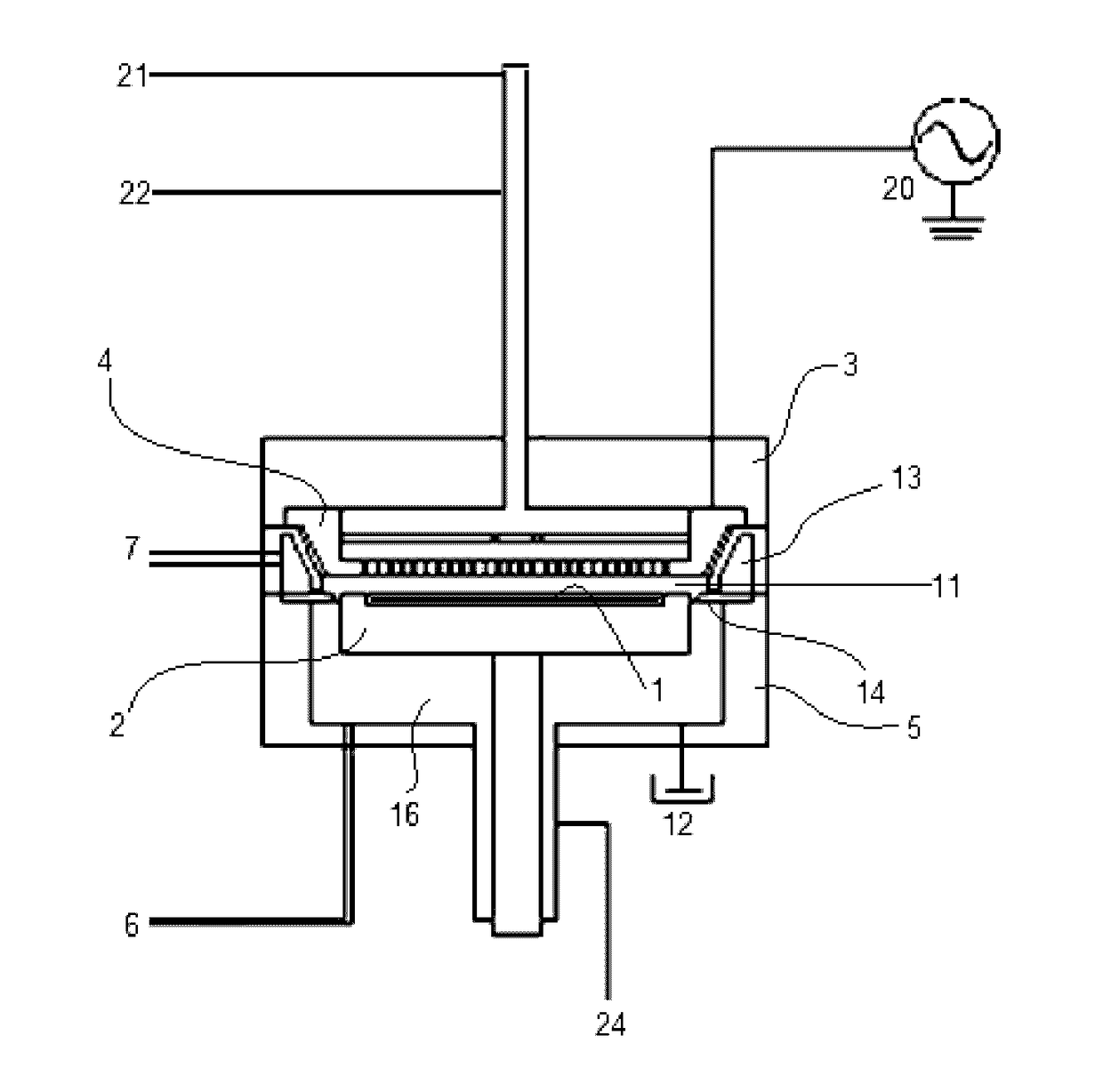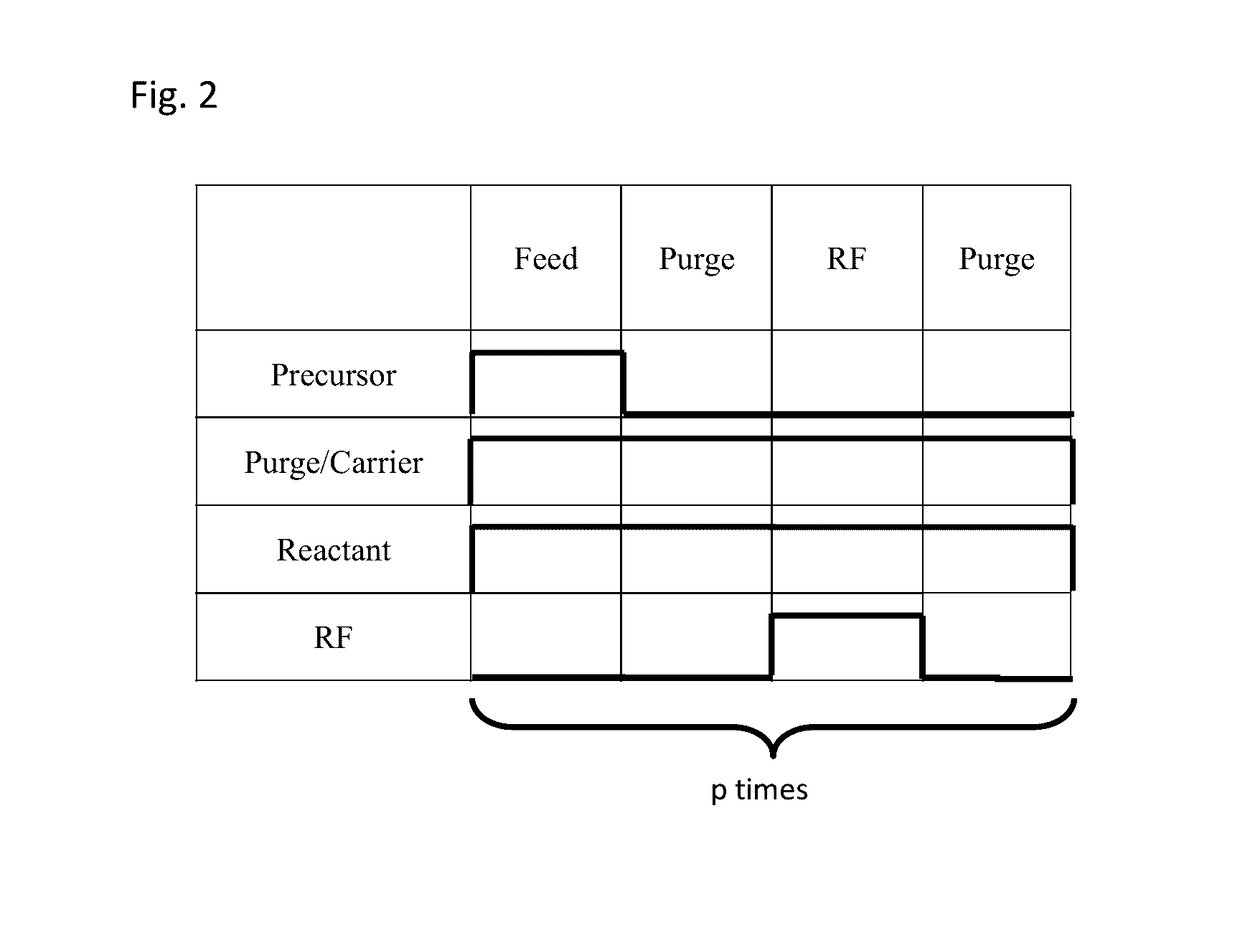Method for depositing dielectric film in trenches by peald
a dielectric film and trench technology, applied in the direction of chemical vapor deposition coating, coating, plasma technique, etc., can solve the problems of insufficient resolution of the etch rate of the difference between the sidewall and the top surface etch rate, so as to improve the quality of the dielectric film
- Summary
- Abstract
- Description
- Claims
- Application Information
AI Technical Summary
Benefits of technology
Problems solved by technology
Method used
Image
Examples
example 1
[0047]A titanium oxide film was formed on a 300-mm substrate having a patterned surface having an aspect ratio of about 2 and an opening depth of about 320 nm under the conditions shown in Table 3 below using the sequence illustrated in FIG. 2 and the PEALD apparatus illustrated in FIGS. 1A and 1B.
TABLE 3Conditions for Deposition CycleSubstrate temperature200° C.Pressure250 PaPrecursorTetrakis(dimethylamido)titaniumPrecursor pulse0.4 secPrecursor purge0.3 secReactantoxygen plasmaFlow rate of reactant (continuous)500 sccmCarrier gasargonDilution gasargonFlow rate of carrier gas (continuous)1000 sccmFlow rate of dilution gas (continuous)500 sccmRF power (13.56 MHz) for a 300-mmSee FIG. 3BwaferRF power pulse0.4 secPurge0.1 secGrowth rate per cycle0.062 to 0.065 nm / cycleTotal thickness [nm]18.6 to 19.4 nm
[0048]The wet etch rate of a part of each film deposited on the top surface of the substrate was measured. The results are shown in FIG. 3B wherein the wet etch rate is expressed as WER...
example 2
[0049]Films were deposited under the same conditions as in Example 1, and the wet etch rate of each film not only on the top surface but also at the sidewall was measured. The results are shown in FIG. 4. As shown in FIG. 3B, the wet etch rate began increasing after hitting the minimum value (the lowest vertex), and FIG. 4 shows the wet etch rate after the lowest vertex. The quality of the film on the top surface obtained at the lowest vertex appears to be the highest. Although the quality of the film on the top surface was the highest at the lowest vertex, the quality of the film at the sidewall was not high, i.e., the wet etch rate of the film at the sidewall was relatively high. Since plasma does not easily reach the sidewall, the quality of the film at the sidewall is not significantly affected by the intensity of RF power, in contrast with the quality of the film on the top surface. The wet etch rate of the film at the sidewall gradually decreased as RF power increased as shown...
example 3
[0050]The film deposited in a trench when RF power was 200 W was analyzed by Scanning transmission electron microscopy (STEM). FIG. 5 shows STEM photographs of cross-sectional views of the film, wherein (a) shows the film as deposited, and (b) shows the film after wet etching. As shown in FIG. 5, the conformality of the film as deposited was 89% at the upper sidewall, 96% at the lower sidewall, and 97% at the bottom, whereas the conformality of the film after wet etching was 83% at the upper sidewall, 90% at the lower sidewall, and 89% at the bottom, i.e., the conformality of the film decreased after wet etching by about 6% to about 8%.
[0051]Also, the film deposited in a trench when RF power was 500 W was analyzed by Scanning transmission electron microscopy (STEM). FIG. 6 shows STEM photographs of cross-sectional views of the film, wherein (a) shows the film as deposited, and (b) shows the film after wet etching. As shown in FIG. 6, the conformality of the film as deposited was 83%...
PUM
| Property | Measurement | Unit |
|---|---|---|
| depth | aaaaa | aaaaa |
| aspect ratio | aaaaa | aaaaa |
| thickness | aaaaa | aaaaa |
Abstract
Description
Claims
Application Information
 Login to View More
Login to View More - R&D
- Intellectual Property
- Life Sciences
- Materials
- Tech Scout
- Unparalleled Data Quality
- Higher Quality Content
- 60% Fewer Hallucinations
Browse by: Latest US Patents, China's latest patents, Technical Efficacy Thesaurus, Application Domain, Technology Topic, Popular Technical Reports.
© 2025 PatSnap. All rights reserved.Legal|Privacy policy|Modern Slavery Act Transparency Statement|Sitemap|About US| Contact US: help@patsnap.com



